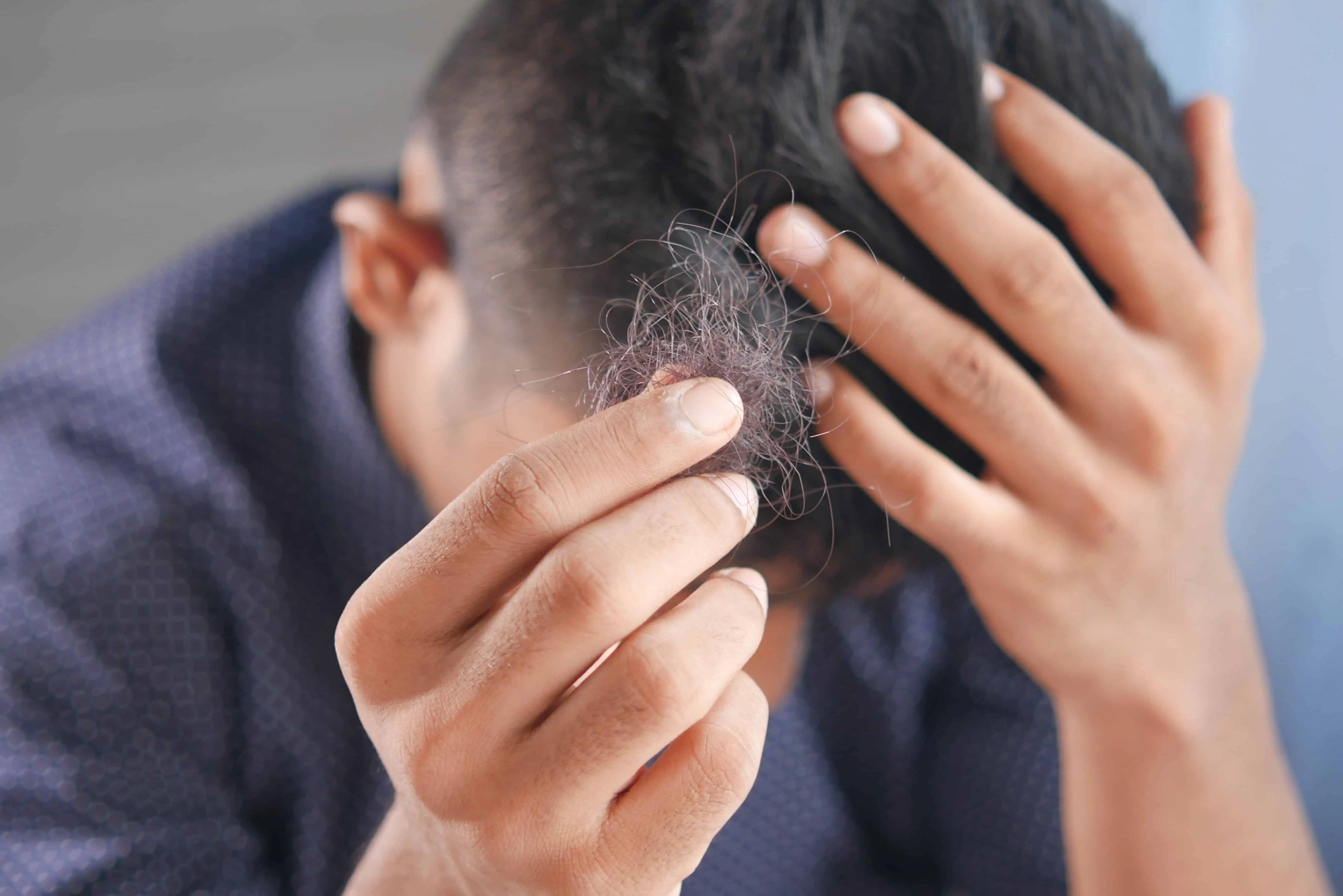Understanding Finasteride Shedding: Impacts on Hair Growth Explained

Content by

Last Updated
Receding Hairline? There's a tablet for that...
Delivered discreetly from our UK registered pharmacy
Table of Contents
- What is Finasteride and How Does It Work?
- What is Shedding?
- Why Does Finasteride Cause Shedding?
- How Long Does The Finasteride Shedding Phase Last?
- When Can You Expect To Experience Finasteride Hair Shedding?
- When Does It Stop?
- How Much Shedding is Normal?
- Can You Prevent or Reduce Shedding?
- Can Finasteride Cause Hair Loss?
- When Can You Expect Finasteride Results?
- The Bottom Line
What is Finasteride and How Does It Work?
Finasteride is a prescription hair loss medication that works to stop – and in some cases reverse – male pattern baldness (MPB). Finasteride is one of the most successful and popular hair loss treatments available today.
Finasteride works by stopping the conversion of testosterone to dihydrotestosterone (DHT). DHT is the hormone that is responsible for causing hair follicles to shrink so that new, healthy hair cannot grow. Thanks to the DHT blocking effect, hair follicles can come back to life, and produce strong, healthy hair again.
What is Shedding?
Shedding occurs naturally and is a daily occurrence. The average man will notice shedding of between 50 to 100 hairs per day. This is part of normal hair growth stages. Once a hair strand reaches the end of its life cycle, it will shed, and a new strand of hair will make way.
Excessive hair shedding may occur due to genetics or it may be triggered by a life event or circumstance.
Excessive Shedding May Be Caused By:
- The recovery process following an illness or surgery
- Pronounced weight loss
- A period of greater than normal stress
- Extreme changes in diet
- Hypothyroidism or hyperthyroidism
Why Does Finasteride Cause Shedding?
After being prescribed finasteride by a doctor or healthcare professional, users can expect the medication to begin working immediately. However, some men are initially concerned about an excess of shedding that can accompany the first few months of treatment.
What is happening is that existing hairs are making way for newer, stronger strands of hair to grow.
The hair growth cycle naturally occurs over four distinct stages:
- Anagen (new hair growth)
- Catagen (transition)
- Telogen (resting)
- Exogen (shedding)

The anagen phase of this cycle normally takes place over a number of years, through which your hair grows to its ultimate length, before entering the resting phase, and eventually falling out. The cycle then repeats.
When you first start finasteride, your DHT levels drop substantially – by up to 70 percent. This causes your hair follicles to enter the anagen (growth) phase more rapidly. Hairs that were in the regression and resting phases of the hair cycle become active, resulting in shedding, so new growth can begin.
If you are amongst the men concerned about losing the little hair you have left, fear not – it’s a natural part of the regrowth process. A study conducted over the course of 10 years discovered that over 99 percent of users see no further progression of their hair loss whilst taking finasteride long term.
How Long Does The Finasteride Shedding Phase Last?
You’ll need to take finasteride for at least 3 months before you notice any improvements in the density of your hair. Those who experience an excess amount of shedding shouldn’t be alarmed, as this is a positive sign that the medication is working. The excess hair loss is in fact older hair leaving the scalp so that thicker and stronger hair can grow in its place.
When Can You Expect To Experience Finasteride Hair Shedding?
- The first two weeks: Temporary shedding is uncommon during this initial stage, although some men may begin to experience hair loss.
- Two months into treatment: The greatest degree of excess hair loss or thinning will be observed at this stage, and typically lasts for two to three weeks.
- Three months after taking finasteride: Excess shedding should now begin to be offset by new growth.
When Does It Stop?
After approximately six months of daily use, most men find that their hair is in fact growing back more rapidly and with a greater density than prior to treatment. After one year of continued usage, you’ll be able to accurately assess how finasteride has worked for you.
Not only should your rate of hair loss be noticeably reduced, but you should be able to enjoy greater hair density where your problem areas used to be.
How Much Shedding is Normal?
Some men are alarmed at the amount of hair loss during the first few weeks and months of finasteride use. If you notice a handful of hair coming out in the shower or after brushing, don’t be concerned – the medication is working.
You may lose a great deal more hair during this stage than the typical 50-100 hairs normally lost over the course of a day. In fact, the shedding period (which only lasts a few weeks) could see you lose up to 300 hairs per day.
Can You Prevent or Reduce Shedding?
Finasteride shedding is a common yet understandably concerning part of a hair restoration protocol. However, there are certain steps you can take to mitigate the amount of shedding you experience in this phase.
You Can Reduce Finasteride Shedding By:
- Implementing a whole food diet rich in nutrients and amino acids: Lean meats (in moderation), colourful fruits, and nuts and seeds are good sources of vital nutrients.
- Reducing the glycaemic load of the foods you eat: Work to eliminate white breads, pastas, and cereals.
- Putting a stop to drinking tap water: Most tap water contains fluoride and heavy metals that can disrupt your endocrine system and create hormonal imbalances. Some studies have linked fluoride in tap water to hair loss.
- Exercising and regulating stress levels: Hair loss can be an incredibly stressful reality for some men. Maintaining a healthy immune system, participating in daily physical activity and regulating stress can keep shedding from worsening while finasteride begins to reduce DHT.
Can Finasteride Cause Hair Loss?
As we have established, hair is shed during the initial stages of treatment with finasteride. This isn’t technically classified as hair loss, as the hair will grow back. Finasteride keeps hair on your head if taken daily – and it can even regrow what you may have lost.
Scientific research and evidence state that finasteride is one of the most powerful treatments for male pattern hair loss. Finasteride reviews outline success amongst many users, and a protocol that combines it with Regaine (a medication containing the active ingredient minoxidil) may provide even greater results.
When Can You Expect Finasteride Results?
Typically, it takes about 3 to 4 months of use for the effects of finasteride to become apparent. However, this timeline can vary slightly for some individuals, depending on the severity of their hair loss.
By the time you reach between 6 and 9 months of treatment, the benefits of finasteride should be more noticeable. After a year of consistent use, finasteride results should be significant enough to be visible to others. If there are no positive changes observed after using finasteride for 12 months, it is advisable to consult with your doctor or pharmacist again.
The Bottom Line
Finasteride use keeps hair, and in many cases regrows what you’ve lost. If you’re interested in joining the millions of UK men who have taken finasteride, consult your doctor or medical professional. Together you can determine if finasteride can help you to reverse the effects of MPB.
Other options, such as topical minoxidil or hair restoration surgery (also known as a hair transplant) may offer alternative solutions or could possibly be used in tandem with finasteride as part of a comprehensive hair restoration protocol.
Ultimately, the degree to which you lose your hair is influenced by genetics and other factors, but it’s comforting to know that help is available if you want it. Finasteride is one of the most powerful and effective treatments available on the market today. If the ultimate goal is restoring a healthy head of hair, a little finasteride shedding is worth it in the long run.
Whilst all of our content is written and reviewed by healthcare professionals, it is not intended to be substituted for or used as medical advice. If you have any questions or concerns about your health, please speak to your doctor.
